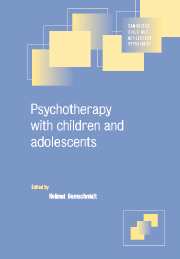Book contents
- Frontmatter
- Contents
- List of contributors
- Preface
- Part I Principles of psychotherapy with children, adolescents and families
- Part II Psychotherapeutic methods and settings
- 5 Psychodynamic therapy
- 6 Behaviour therapy
- 7 Cognitive behaviour therapy
- 8 Interpersonal psychotherapy for adolescents
- 9 Play therapy with children
- 10 Individual psychotherapy with adolescents
- 11 Group psychotherapy and psychodrama
- 12 Family therapy
- 13 Parent training
- 14 Combination of treatment methods
- Part III The practice of psychotherapy for specific disorders in childhood and adolescence
- Part IV The practice of psychotherapy in various settings
- Index
6 - Behaviour therapy
- Frontmatter
- Contents
- List of contributors
- Preface
- Part I Principles of psychotherapy with children, adolescents and families
- Part II Psychotherapeutic methods and settings
- 5 Psychodynamic therapy
- 6 Behaviour therapy
- 7 Cognitive behaviour therapy
- 8 Interpersonal psychotherapy for adolescents
- 9 Play therapy with children
- 10 Individual psychotherapy with adolescents
- 11 Group psychotherapy and psychodrama
- 12 Family therapy
- 13 Parent training
- 14 Combination of treatment methods
- Part III The practice of psychotherapy for specific disorders in childhood and adolescence
- Part IV The practice of psychotherapy in various settings
- Index
Summary
Introduction
Behaviour therapy is the attempt to modify human behaviour and emotions, positively based on the rules of learning theory (Eysenck, 1964). The term ‘behaviour therapy’ obviously refers to behaviour, however, Eysenck extended the definition to include those internal processes we call ‘emotions’. Since cognitive behaviour therapy was introduced in the 1960s, verbal, cognitive and motivational factors have increasingly been taken into account. Earlier views, which held that all internal mental factors should be ignored for methodical reasons, are no longer tenable.
The theoretical basis of behaviour therapy has been expanded considerably since its introduction. Until the 1950s, behaviour therapy had been based to a considerable extent on learning theory, especially Pavlov's concept of classical conditioning, Thorndike's learning theory of the association between stimulus and response, Hull's formal learning theory, and Skinner's paradigm of operant conditioning. Subsequently, the theoretical basis of behaviour therapy extended beyond this to include findings and theories from general and social psychology, as well as from neuropsychology. Related fields such as physiology and neurophysiology have also contributed to the development and application of behavioural methods, which today form an essential part of the relatively new discipline of behavioural medicine.
In contrast to the changing theoretical foundations, some basic methodological problems retaing to behaviour therapy have persisted. Behaviour therapy should, however, be informed by empirical and experimental findings (Graham, 1998).
The concept of the human being in behaviour therapy has gradually changed. In contrast to previous views, where human beings were regarded as organisms who react passively to environmental stimuli, today human beings are considered active subjects with a self-conscience, who plan and undertake actions in an organized way.
- Type
- Chapter
- Information
- Psychotherapy with Children and Adolescents , pp. 98 - 112Publisher: Cambridge University PressPrint publication year: 2001
- 1
- Cited by



